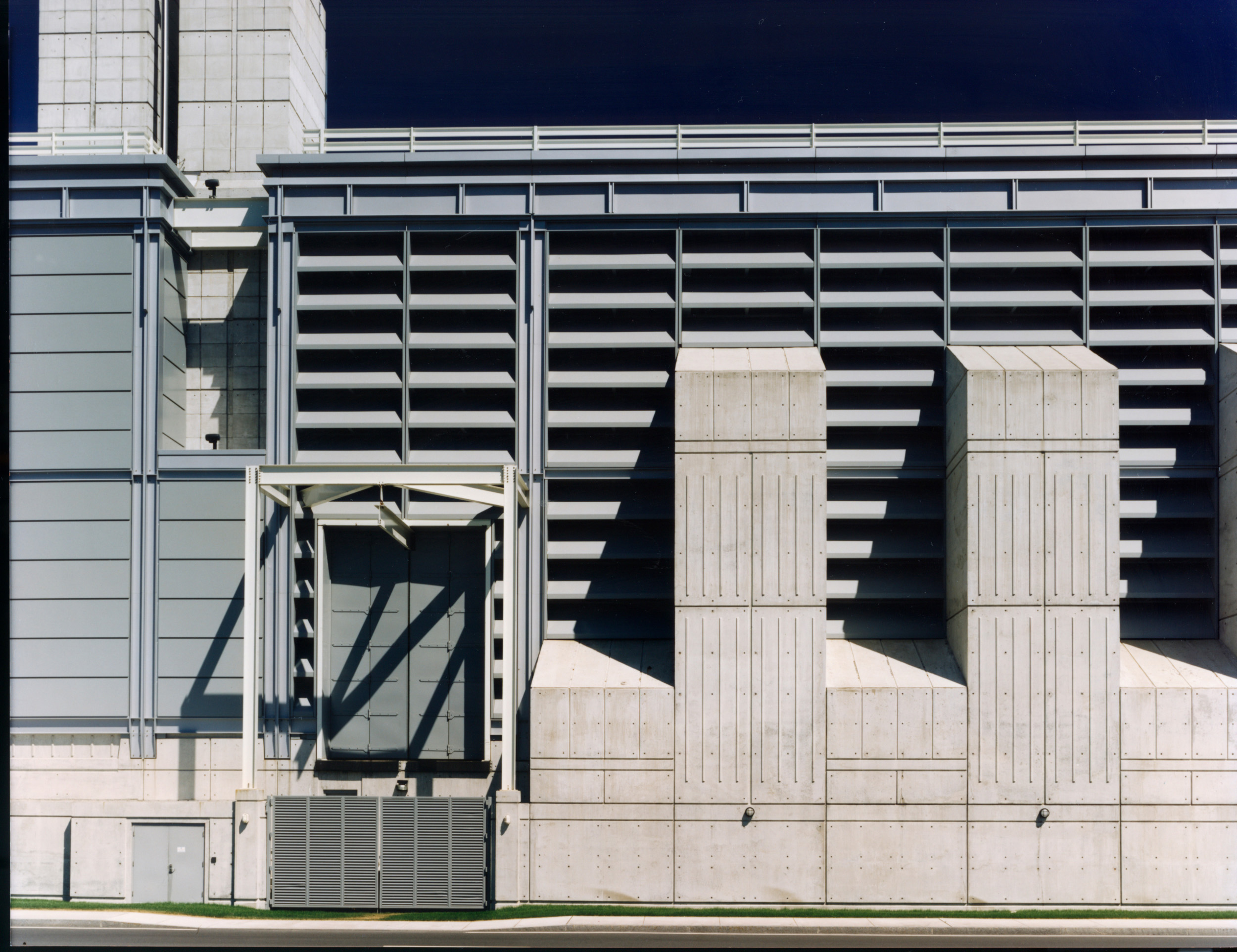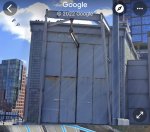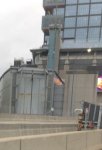Why does the rear of the building (the part that faces the highway ) have those things that look like large doors and the rail coming out of the top, right in the middle?
You are using an out of date browser. It may not display this or other websites correctly.
You should upgrade or use an alternative browser.
You should upgrade or use an alternative browser.
Vent building 8
- Thread starter Zdboslaw
- Start date
Brattle Loop
Senior Member
- Joined
- Apr 28, 2020
- Messages
- 1,167
- Reaction score
- 2,084
Why does the rear of the building (the part that faces the highway ) have those things that look like large doors and the rail coming out of the top, right in the middle?
This is a guess, but maybe for moving/installing equipment.
Vent Building 7 has something similar (not my photo, unfortunately):

Last edited:
RandomWalk
Senior Member
- Joined
- Feb 2, 2014
- Messages
- 3,310
- Reaction score
- 5,167
That is a nice photo of Vent Building 7. The interplay of light, shadow and geometry is striking.
- Joined
- Dec 10, 2011
- Messages
- 5,599
- Reaction score
- 2,717
My guess is that there is a very big fan behind that door that they want to be able to swap out “whole” & quickly at the end of its service life, and that you’ll find a similar door in a similar place on most or all built at the same time.
Specifically, thats a craneway known as a "monorail door." Monorail in this case is a specific type of overhead crane - most industrial overhead cranes, bridge and girder, facilitate full translational movement in 2 dimensions, X and Y with the hoist lift representing Z. Monorail cranes don't have that XY freedom - they're only useful for lifting in the vertical axis along it's track, but they work along the same basic principles as a transit monorail, complete with switches, crossovers and turntables. A major benefit is that the track can curve, and can support multiple trolleys. They're not the strongest, but ideal for mid-weight repetitive motions, like moving something along an assembly line.
Here I would agree that it's definitely for equipment replacement and repair - I would bet that rail runs above each major replaceable item / access point to allow an integrated hoist to lift and stage them to/from a location where a road mobile crane/truck can reach.
Here I would agree that it's definitely for equipment replacement and repair - I would bet that rail runs above each major replaceable item / access point to allow an integrated hoist to lift and stage them to/from a location where a road mobile crane/truck can reach.
Last edited:
MjolnirMan
Active Member
- Joined
- Jan 18, 2016
- Messages
- 256
- Reaction score
- 574
While there's an active thread about vent building design, can I ask a related question that I assume has the mundane answer "it was moderately cheaper to do it this way":
Why was virtually no effort made, with the exception of CAT Vent Tower 6, to integrate the design of these stacks into the existing street grids? I understand that some equipment has to be aligned with the tunnel geometry, but thinking of the one across from the BCEC in particular, it seems like the actual building housing the equipment could have been integrated better into the city to create fewer headaches going forward. Similar issues exist for the older Callahan/Sumner towers in the North End and Eastie, which are decorated in lovely brick and with nonzero architectural touches, but then splayed at odd angles to other property.
Why was virtually no effort made, with the exception of CAT Vent Tower 6, to integrate the design of these stacks into the existing street grids? I understand that some equipment has to be aligned with the tunnel geometry, but thinking of the one across from the BCEC in particular, it seems like the actual building housing the equipment could have been integrated better into the city to create fewer headaches going forward. Similar issues exist for the older Callahan/Sumner towers in the North End and Eastie, which are decorated in lovely brick and with nonzero architectural touches, but then splayed at odd angles to other property.
There was a post about them a couple of months ago in the General infrastructure thread, and while I can't answer the question about the alignment generally, at least 2 others were aligned to the street and hidden by other construction - Vent 3 in the intercontinental and 4 by the Public Market and Haymarket Headhouse/Garage. The one by BCEC though? I'm not sure how you could align that one much better being as it is completely hemmed in by roadways. Maybe if the adjacent parcel gets an air rights deal?
As to the Callahan and Sumner ones though, you're not wrong that they're really obviously askew, but I would probably just chalk that up to the era in which they were built and the relative simple structural considerations of aligning it with the tunnel. Edit: looking at Google maps, it looks like they vent through the faces of those buildings and not the top. If that was a technology limitation of the 1930s, in that case I can totally see why they aren't aligned - a party wall simply wouldn't work, and a askew orientation probably provides better airflow.
As to the Callahan and Sumner ones though, you're not wrong that they're really obviously askew, but I would probably just chalk that up to the era in which they were built and the relative simple structural considerations of aligning it with the tunnel. Edit: looking at Google maps, it looks like they vent through the faces of those buildings and not the top. If that was a technology limitation of the 1930s, in that case I can totally see why they aren't aligned - a party wall simply wouldn't work, and a askew orientation probably provides better airflow.
In the quiz thread, I promised a full listing of the highway ventilation buildings in Boston. There are 13 ventilation buildings, one air intake, and three fan chambers. Images are from Street View, with a few of mine mixed in.
Ventilation Building 1 is on Dorchester Avenue next to Rolling Bridge Park. It is the west structure for the Fort Point Channel Tunnel.
View attachment 29137
Ventilation Building 3 is in fact the east core of the Intercontinental, on Atlantic Avenue at Pearl Street. It serves the Central Artery. No sign of its ventilation use is visible from ground level.
Ventilation Building 4 is at Haymarket Square and serves the Central Artery. The structure includes a parking garage, the RMV, the Boston Public Market, and the south headhouse of Haymarket station. Unlike Building 3, the vent stacks are clearly visible.
View attachment 29138
Ventilation Building 5 is on Summer Street opposite the BCEC, at the east end of the Fort Point Channel Tunnel.
View attachment 29139
Ventilation Building 6 is on Fid Kennedy Way at the south end of the Ted Williams Tunnel.
View attachment 29140
Ventilation Building 7 is on Harborside Drive at the north end of the Ted. It's the largest of these large structures - 380 feet long and 140 wide - and won a couple of design awards.
View attachment 29141
Ventilation Building 8 is tucked between the North Station platforms, the Leverett Circle Connector bridge, and the Zakim bridge and a southbound onramp.
View attachment 29142
Ventilation Building 10[url] is on North Street near the Boston end of the Sumner Tunnel.
View attachment 29143
Its twin, [url=https://www.google.com/maps/@42.3716348,-71.0411389,80m/data=!3m1!1e3]Ventilation Building 11, is on Liverpool Street in East Boston. (Liverpool Street, like several nearby streets, is named for the port city its docks once served ships to.)
View attachment 29144
Ventilation Building 12 is at North Street over the Boston portal of the Callahan Tunnel.
View attachment 29145
Its twin, Ventilation Building 13, is on Decatur Street in East Boston.
View attachment 29146
Though barely a thousand feet long, the City Square Tunnel (CANA) has two ventilation structures. Ventilation Building 14 is on New Rutherford Avenue adjacent to some ghost ramps.
View attachment 29147
Ventilation Building 15, at the corner of Warren and Chelsea, is designed to fit in with the nearby brick buildings.
View attachment 29148
The Dewey Square Air Intake is well known on this forum for the murals it hosts.
View attachment 29149
Three fan chambers date to the 1950s construction of the Dewey Square Tunnel; a fourth was located in Dewey Square until the Big Dig. The Essex Street Fan Chamber and Summer Street Fan Chamber flank Surface Road between their namesake streets,
View attachment 29150
The Beach Street Fan Chamber is adjacent to Chinatown Gate. It was wrapped with this artwork about a decade ago.
View attachment 29151
Some useful links:
Map of all CA/T facilities and structures
2021 inspection report with detailed list of facilities
Last edited:
MjolnirMan
Active Member
- Joined
- Jan 18, 2016
- Messages
- 256
- Reaction score
- 574
Thanks so much! I guess it's a kind of survivorship bias that I forgot about these extremely well-hidden/aligned ones, while even the smaller Dewey Square Tunnel vents stick out like sore thumbs.Vent 3 in the intercontinental and 4 by the Public Market and Haymarket Headhouse/Garage



